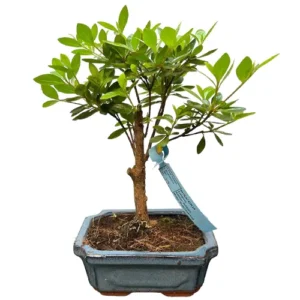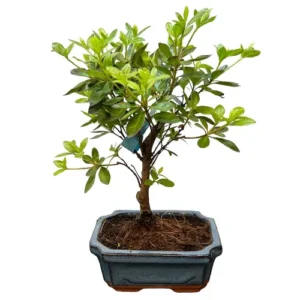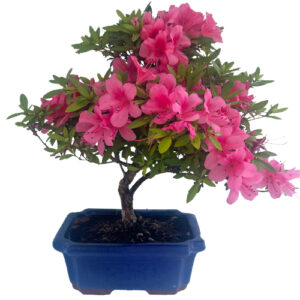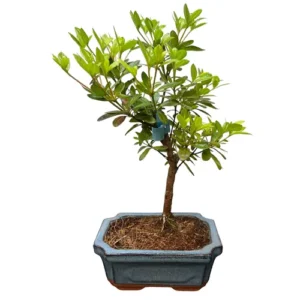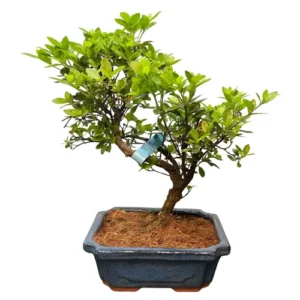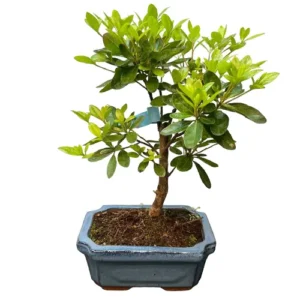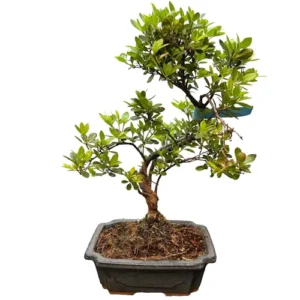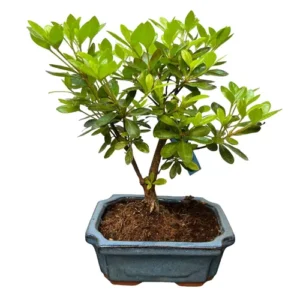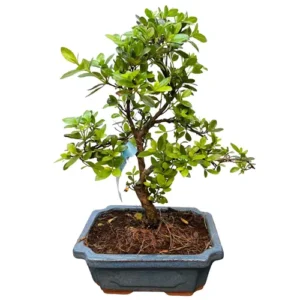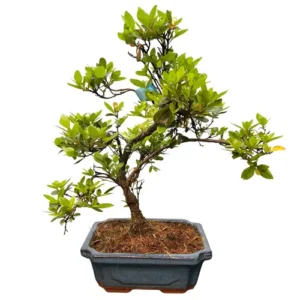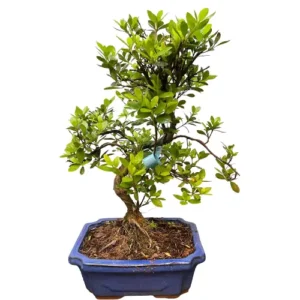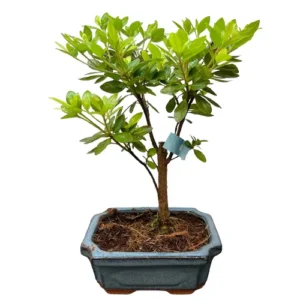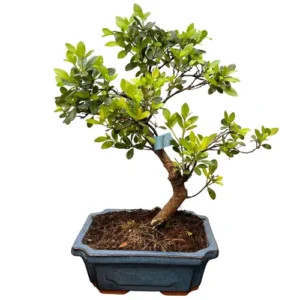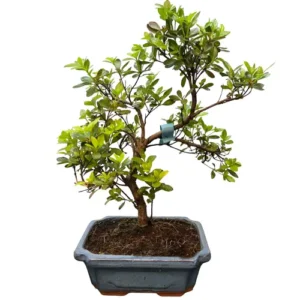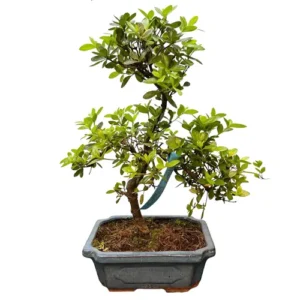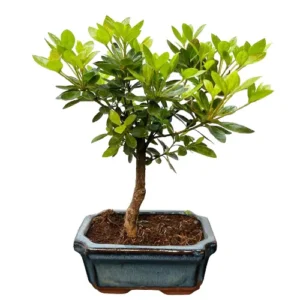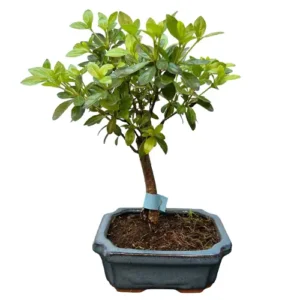Rhododendron Indicum
Satsuki Azalea Bonsai
The satsuki azalea is the most popular flowering bonsai, producing a stunning display of red, pink and white blooms every spring. When not in flower, it is an attractive evergreen species that is native to Japan.

Satsuki Azalea Bonsai Care Tips
Placement
The azalea is an outdoor bonsai species and you should choose a location for it which replicates the woodland environment they have evolved in. They do best when they are provided with a lot of sun to help ripen the shoots from which flowers will come, but also provide it with some shade, especially during the hottest parts of summer days.
During winter, your azalea will require a dormant period which can be achieved with temperatures around 2-12 °C but it is important to protect from temperatures lower than this and especially frost. This can be done by moving the azalea to a cold frame, unheated greenhouse or by using insulation.
Watering
There is no definitive guide to watering and it should be conducted on an observational schedule, not a routine. This means that it is important to keep an eye on the moisture levels of the soil to avoid over and under watering, both which can lead to dropping leaves and/or root death. The amount of water a bonsai requires depends on pot size, climate, airflow, soil and tree type so it is best to use your eyes and fingers to assess whether the soil is damp, wet or dry.
If the top inch or so of soil has dried, it is ready to be watered. When you water, try to get an even coverage over the roots and soil, allowing water to flow out from the bottom of the pot to ensure a good soaking.
If you are a first-time bonsai owner, another way to water is by submerging the entire pot in water until the bubbles stop. If you choose this method, be aware that your bonsai may not need watering for another two to four days, but this will depend on the factors mentioned above such as soil type, pot size and climate.
Feeding & Fertilising
Using fertiliser on your azalea will help encourage healthy growth and this should be done periodically from once a week to every two months and only during the growing season. You can start adding Chrysal Liquid Bonsai Feed to your water from March until October and use weekly. Use Naruko Fertiliser Slow Release Bonsai Feed once every one to two months. With bonsai trees, less is more, and we tend to advise using half the recommended dosage to see how your bonsai reacts first.
Regular feeding is essential to your azalea tree’s flowering and if not done properly could result in no flowers some years. However, during the blooming period, reduce the amount of feeding by half or stop altogether to favour flowering over vegetative growth.
Pruning & Wiring
Pruning your bonsai is important not only to maintain or create an aesthetic style but to also ensure light and airflow can reach inner leaves and the azalea tolerates aggressive pruning well. The base of the shrub will need harder pruning than the twigs and branches on top since it is one of the few species suitable for bonsai that grows basally. As soon as the flowers have wilted and died, pinch or cut them off. Remove the whole flower, including the dead petals and the whole bud from which it came. In this time period, begin pruning the branches and leaves too, since the buds for next year’s flowers will form in summer. If left too late into the year you could risk losing them during the pruning process.
Training your azalea bonsai using wiring should be conducted with great care as the wood is very brittle. We recommend using wires with a thickness that matches the thickness of the branch: if the wire you choose is too thick you will damage the bark. If it is too thin, it won’t be effective.
Repotting
Repotting your tree is an important way to provide a fresh and suitable soil mix and ensure appropriate root health. Repot in spring or after flowering. Generally, your Azalea will need to be re-potted once every two years if it is young, while older ones can stay in their pots for longer. However, you should always check if it has become root-bound before you change pots. You can do this by lifting the tree gently out of the pot by the main trunk and examining the root system. You will know it is ready if you can see that the roots are circling around each other and the pot. If, however, they still appear contained in the soil, you should place it back and wait until the following spring to check again.
Trees that are ready for repotting will require root pruning, a suitable new pot and appropriate soil mix.
Note that the Azalea has roots that must be pruned with care as they are often tightly matted, thin, and tear easily. It is also important that the soil mix you choose for the new pot is lime-free and we tend to use a mixture of different speciality bonsai soils on our trees. When repotting, do not cut back the root mass by a large amount, and choose a well-draining soil mix that has a neutral or slightly higher PH value of 5-6 but not over 7. We tend to use a mixture of different speciality bonsai soils on our trees. Every species is different so please contact us for free soil-mix advice or to take advantage of our repotting service.
Bonsai trees aren’t only magnificent additions to an indoor oasis, they are more than capable of standing out in any garden. Many Bonsai species are incredibly hardy and withstand nature’s colder and damper turns with aplomb making them worthwhile outdoor plants. We have an extensive library of care guides for outdoor bonsai trees. It’s not about selecting the perfect bonsai, it’s about selecting the perfect bonsai for you.
Satsuki Azalea Bonsai - Typical Queries
How often do Satsuki Azalea Bonsai bloom?
Satsuki Azalea Bonsai usually bloom once a year, typically in late spring or early summer. The flowering period can last from a few weeks to a few months, depending on the variety and the growing conditions. Some Satsuki Azaleas may produce a second flush of flowers in autumn, but this is less common and less spectacular than the main bloom.
Why are the leaves on my Satsuki Azalea Bonsai turning brown?
Brown leaves on a Satsuki Azalea Bonsai can indicate several problems, such as overwatering, underwatering, root rot, nutrient deficiency, sunburn, or pest infestation. To diagnose the cause, check the soil moisture, the roots, the foliage, and the environment of your bonsai. Depending on the issue, you may need to adjust your watering schedule, apply a fungicide, move your bonsai to a shadier spot, or treat it with an insecticide.
Do Satsuki Azalea Bonsai lose their leaves?
Satsuki Azaleas are evergreen plants, which means they do not lose their leaves in winter. However, they may shed some older leaves throughout the year, especially after flowering. This is normal and does not indicate a problem. You can remove the fallen leaves from the soil surface to keep your bonsai tidy and prevent fungal growth.
How do I propagate my Satsuki Azalea Bonsai?
Propagating your Satsuki Azalea Bonsai is a rewarding way to create new plants from your existing one. You can propagate your bonsai by taking cuttings, layering, or grafting. Cuttings are the easiest and most common method, and can be taken from healthy, young branches in spring or summer. You can dip the cut end in rooting hormone, and insert it into a moist, sterile potting mix. You can then cover the pot with a plastic bag, and place it in a warm, bright location. You can expect roots to form in a few weeks, and then you can transplant your new bonsai into a suitable pot.
What are the best varieties of Satsuki Azalea Bonsai?
- There are hundreds of varieties of Satsuki Azalea, each with its own unique characteristics and charm. Some of the most popular and beautiful varieties of bonsai are:
- Gyoten: This variety has large, double, pink flowers with white stripes and spots. It blooms profusely and has a compact habit.
- Kinsai: This variety has small, single, red flowers with a yellow centre. It blooms early and has a graceful shape.
- Osakazuki: This variety has medium, single, white flowers with a red border. It blooms late and has a vigorous growth.
- Chinzan: This variety has small, double, salmon-pink flowers with a darker center. It blooms abundantly and has a dense foliage.
- Kaho: This variety has large, single, white flowers with a pink blush. It blooms sporadically and has a slender form.

